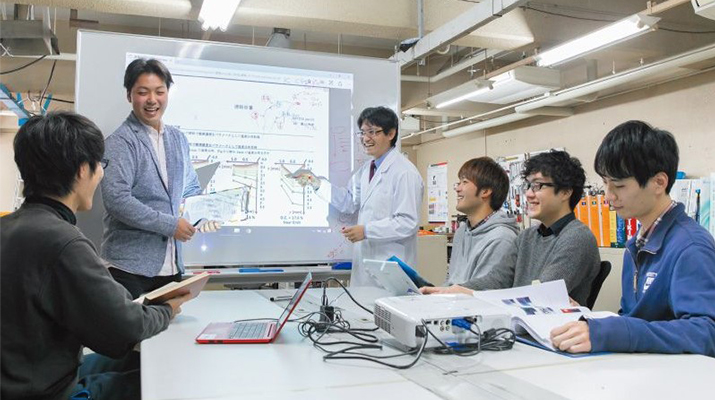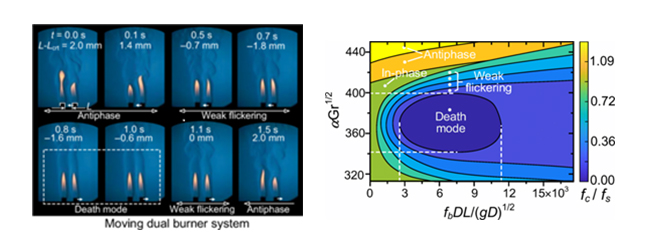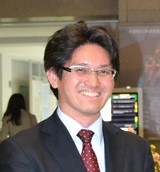
ここからコンテンツです。

"Magic" in the flickering of flames
Fluctuation can be controlled by adjusting the distance between two flames Yuji Nakamura
A research team, led by Professor Yuji Nakamura of the Department of Mechanical Engineering at Toyohashi University of Technology, discovered that the flickering of flames can be freely controlled by moving two flames closer together or further apart. Until now, it had been known that interference between flames separated by a certain distance causes the flames to flicker during in-phase or anti-phase. However, it was not possible to stably express the state of "stopping the flickering of flames" that should occur under critical conditions where the phase changes. The research team succeeded in stably expressing the state of "stopping the flickering of flames" by periodically adjusting the distance between flames closer and further apart. This makes it possible to freely control the flickering of the flames, and to elucidate the essence of flickering flames.
The flickering of flames is a very familiar phenomenon that is easy to observe. At the same time, it is also a mysterious and interesting phenomenon with vast complexity. For example, once the flickering flames have interfered with each other, only the stable flickering mode is selectively expressed. Depending on the distance between the flames, the "in-phase mode" that fluctuates in the same phase and the "anti-phase mode" that fluctuates in the opposite phase are selectively expressed. Also, the frequency of the fluctuation differs among these modes, which is a curious phenomenon. Although it is possible to achieve various fluctuating states in this way, there is no example that shows "stopping the flickering by interfering with the fluctuating flames." In the past, it was shown that this state can be achieved by arranging three flames (known as "death mode" in reference to the complete absence of movement). However, researchers have yet to understand the reason why death mode cannot be achieved with two flames.
When examining this theme, the research team found that the death mode is expressed by adjusting the distance between the two flames closer or further apart in a certain cycle.

"When conducting experiments involving flame-to-flame interference, flickering will temporarily stop if the flames are gradually brought closer or further apart," explains Dr. Ju Xiaoyu, lead author and researcher at the time of the project. "However, if the flames are kept in that position, they will eventually start flickering again. Since the flames eventually flicker, we know that flickering is a stable state. The fact that there is a delay period until the flames settle into a stable state means that if we can create a situation where flickering can be stopped within that time scale, the flickering should be stopped permanently. We were able to prove that this prediction is correct by periodically adjusting the distance between flames closer and further apart. We also demonstrated that the reason for this phenomenon can be explained by hydrodynamic properties. Moving forward, we will proceed with research aimed at constructing a theory."
"It has been known that the flame flickering mode is determined by interference between flames," says Professor Yuji Nakamura, leader of the research team. "Researchers in applied physics have attempted to explain this phenomenon as nonlinear physics instead of combustion engineering. Nevertheless, their explanation felt inadequate to me due to its failure to consider hydrodynamics. In response, I began to research this theme in earnest. I was amazed to witness a phenomenon in which flickering temporarily stopped in an intermediate state between in-phase and anti-phase flickering. I felt a strong desire to elucidate this mysterious transition state, a theme which has not been addressed by previous research. From the beginning, I had the idea of constantly adjusting the distance between flames to take advantage of the time delay until they settled into a stable state. Ultimately, I was able to organize this method with the help of Dr. Ju."
Professor Nakamura concludes: "Introducing this phenomenon at events such as academic conference is guaranteed to capture the interest of the audience. However, it is just as certain that the audience will, raise questions about possible practical applications, such as ´What is it useful for?´ When facing such questions, I always respond by posing a question of my own—‘To be honest, I only began researching this phenomenon out of personal curiosity, so let me ask you, in what ways do you think my findings can be used?’ This experience has led me to start my research presentations by asking the audience to refrain from questions on practical application. I believe that one appeal of conducting basic research at a university is being able to purely immerse yourself in curiosity, without the need to consider practical application."
Although the research team is not considering practical applications of their research at the present time, they plan to delve deeper into the theme not only through experiments, but also through numerical and theoretical analysis. This will be done in the name of basic research that is unique to universities; that is, through the elucidation of mysterious phenomenon. The team plans to proceed as an international joint research in collaboration with Dr. Ju and many other international researchers who have expressed interest in their research. Through the international dissemination of research ideas originating in Japan, the team would like to showcase to the world that Japan is a place where this kind of (currently impractical) basic research can be pursued to the fullest extent.
Reference
Ju, X., Bunkwang, A., Yamazaki, T., Matsuoka, T., and Nakamura, Y., "Flame Flickering Can Cease under Normal Gravity and Atmospheric Pressure in a Horizontally Moving Dual Burner System", Physical Review Applied, Vol.19, No.1 (2023.1) eid 014060
DOI: 10.1103/PhysRevApplied.19.014060
https://journals.aps.org/prapplied/abstract/10.1103/PhysRevApplied.19.014060
ゆらぐ炎の「摩訶不思議」を解き明かす
2つの炎の距離を動かすことでゆらぎは制御できる中村 祐二
豊橋技術科学大学機械工学系中村祐二教授の研究チームは、2つの炎を互いに近づけたり遠ざけたりすることで火炎のゆらぎを自在に制御できることを見出しました。これまで、ある距離を離した炎同士が干渉することで、同位相・逆位相で炎がゆらぐことは知られていましたが、位相が移り変わる臨界条件で発現するはずの「炎のゆらぎが止まる」状態を安定して発現させることはできませんでした。研究チームは、「炎のゆらぎが止まる」状態を、炎同士の距離を周期的に近づけたり遠ざけたりすることで安定的に発現させることに成功しました。これにより、炎のゆらぎ状態を自由自在に制御することができ、炎のゆらぎの本質に迫ることができます。
炎のゆらぎとは、普段から容易に観察される馴染み深いものである一方、様々な様相を示す不思議で面白いものでもあります。例えば、一旦ゆらいでいる炎同士が干渉すると安定的なゆらぎモードだけが選択的に発現します。炎の距離に応じて、同じ位相でゆらぐ「同位相モード」、逆の位相でゆらぐ「逆位相モード」が選択的に発現します。また、それらのモードではゆらぎの周波数が異なるといった不思議なことが起きます。このように様々なゆらぐ状態が実現できるのですが、「ゆらいでいる炎を干渉させてゆらぎを止める」ことを示した例はありません。この状態は、過去に3つの炎をある配列することで実現されることが示されましたが(動かない、という意味で「デス・モード」と名付けられました)、何故それが2つの炎ではできないのかが明確になっていませんでした。
そこで研究チームは、2つの炎同士の距離をある周期で近づけたり遠ざけたりすることでデス・モードを発現させることを見出しました。
「炎と炎の干渉実験を行うにあたり、徐々に近づけるまたは遠ざけると、途中でゆらぎが一時的に止まります。ところが、その位置に留めておくと、いずれまたゆらぎ始めます。最終的にはゆらぐので、その状態が安定状態であることはわかるのですが、安定状態に落ち着くまでの「遅れ時間」があるならば、その時間スケール内でゆらぎを静止できる状況を作れば、ずっと静止させられる可能性があるのでは、と考えました。そこで、炎の距離を周期的に近づけたり遠ざけたりすることでこの推定が正しかったことを証明することができました。また、この理由は流体力学的な特性で説明できることを示しました。今後は理論構築に向けた研究を進めていきます。」と筆頭著者である研究員(当時)のJu Xiaoyu博士は説明します。
研究チームのリーダーである中村祐二教授は「もともと炎同士の干渉により炎のゆらぎモードが決まることは知られていました。この現象は燃焼工学ではなく非線形物理学として応用物理の研究者によって説明が試みられていましたが、その説明では流体力学的な考察が含まれておらず、無理があると感じました。そこで本格的にこの研究に取り組み始めたのですが、同位相と逆位相のゆらぎの中間状態で一時的に制止する現象を目のあたりにして、こんなことがあるのか、と衝撃を受けました。これまでの研究では一切触れられていないこの奇抜な遷移状態をどうしても解明したいと思いました。安定状態に落ち着くまでの時間遅れを利用するために、炎同士の距離を絶え間なく動かすという発想は当初からもっていたのですが、丁寧な制御が不可欠でした。Ju博士の協力を得てようやく整理することができました。」
中村教授はこう結びます。「この現象を学会等で紹介すると、例外なく聴講者の興味を鷲掴みにできますが、やはり例外なく「一体何の役に立つのですか?」という応用例への質問を受けます。もともと私自身も興味本位で始めただけなので、あなたはどう思いますか、と質問で切り返していたのですが、キリがありません。最近では、紹介の冒頭で「役に立たないので応用に関する質問はNGです」と伝えることにしています。応用は一切考えないと割り切り、純粋に知りたいことに没頭できることも大学での基礎研究の魅力と信じています。」
この研究の応用展開は、今も全く考えていませんが、不思議な現象解明を通じて掘り下げるという、大学らしい基礎研究として、実験のみならず数値解析や理論解析を通じてさらに進めていく予定です。Ju博士や本研究に対して打診をいただく多くの欧米研究者と共に、国際共同研究として展開してゆきます。この活動を通じて、日本ではこんな(役立たない)基礎研究が存分にできること、それが許されること自体が他の国と比べられない日本の大学の良いところなのだということを、世界に向けて発信し続けたいと考えています。
Researcher Profile

| Name | Yuji Nakamura |
|---|---|
| Affiliation | Department of Mechanical Engineering |
| Title | Professor |
| Fields of Research | Combustion / Fire Dynamics / Scale Modeling / Space Engineering / Safety Engineering |
ここでコンテンツ終わりです。
